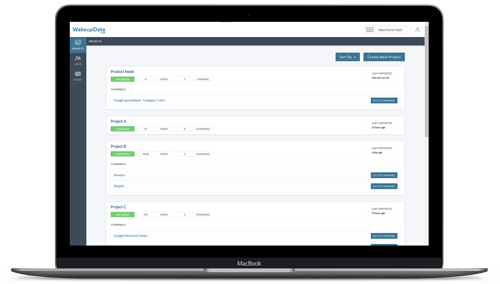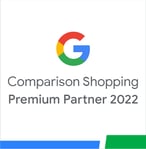Using Custom Labels for Google Shopping campaigns
Posted on August 6, 2019 (Last Updated: March 04, 2024)
You probably already know the ways that you can create product groups on Google Shopping.
They allow online merchants to split their product listings based on factors like Category, Product Type, ID, Condition or Brand. Learn how to use Google shopping feed custom labels with us.
But sometimes those factors can be limiting. That's where Custom Labels come in.
When you want to separate your product listings based on other attributes, Custom Labels are the perfect solution, based on the conditions which you decide upon.
What are Custom Labels for Google Shopping?
As we saw with Facebook Custom Labels, these consist of 5 optional columns which let you split the biddings into specific ad groups within your Shopping Campaigns.
In this article we'll take a look at some common custom label examples, and illustrate how they can be used in bidding, reporting and optimizing your Google campaigns.
The products in your feed will vary by price, margins, seasonality, etc.
|
Custom label
|
Definition
|
Values
|
|
0
|
Margin
|
High, low
|
|
1
|
Price category
|
€0-20, 21-50, 51-100,
|
|
2
|
Season
|
Spring, Summer, autumn, winter
|
|
3
|
Sale
|
Clearance, half price
|
|
4
|
Shipping
|
Free, standard
|
When you create your custom labels, you simply assign a definition for each and specify the values for each.
Bear in mind that each of the custom labels can only have one value for each product. Being consistent by applying these to all the relevant products in your feed will allow you to truly reap the rewards - which we'll look at in a moment.
Custom Labels application
As I mentioned above, it's up to you how and when you apply your custom labels, depending on what you are selling, your pricing strategies, your high and low seasons, etc.
Let's take a look at some examples from the table above to give some inspiration:
Season
Many sellers stock season-specific items that are intended for a particular time of year.
This might be beach gear for the summer or warm outdoor gear for the winter.
By applying seasons to your custom label you can alter how you bid throughout the year, increasing bids to win auctions on Google when you want to sell more of that product type and lowering bids when sales will be lower.
Makes sense right? Plus, doing this through custom labels removes the need to manually add and remove season-specific products to the master feed.
Our client, Festmagasinet, did exactly this, applying seasonal custom labels to their products (costumes like Halloween, Easter, New Year, and Oktoberfest) to see a 168% increase in impressions. Get the full story here:
Price Category
Often, there can be a wide variation in the pricing of products listed on Google by your online store.
Some may be priced at €5 while some might be priced at €5000. It doesn't make sense to be bidding the same across this massive price range, and Google doesn't let you separate by price - so segmenting products through custom labels can be the perfect solution.
To get a solid ROI, your max CPC for your less expensive products can be a lot lower than the max CPC for higher priced products. E.g:
- Ad group 1 - €5-€20 (CPC of €1)
- Ad group 2 - €21-€50 (CPC of €3)
- Ad group 3- €51-€200 (max CPC of €5)
Margin
Similarly, you can separate your products based on the profit you make - rather than grouping them based on price.
Although you might have several products selling for the same price, they might have very different profit margins from each other.
By segmenting with custom labels you can adjust more of your ad spend towards those products which give you the best ROI.
Sale
When it comes to adding sales or promotions to a custom label, the choice is yours.
If you want to get rid of stock for these cheaper items ASAP, you can raise the CPC on these groups.
On the other hand, you might be more interested in keeping a strong ROI. Therefore, you don't necessarily want to push these lower-margin products to your audience, so could lower bids on these sales items instead.
Setting up your Custom Labels:
So now we've had a look at just some of the possible uses for Custom Labels, let's see how they could be applied to your campaigns:
1. Plan and assign your Custom Labels
Most important is to decide the definition of each label. This might be done in a spreadsheet which simply states each label phrase and what that means, e.g:
- Low-price = products under €15
- Promotion = reduced products
It's not so important what you call each label definition (as long as you can recall it later!), what matters is that it follows the same style throughout.
Now you can assign each of your products into their custom label categories.
2. Add your Custom Labels to the Product Feed
There are different options to carry out this procedure, the easiest of which is a feed marketing tool like WakeupData...obviously! 😏
Feed Marketing Tool
In the video below you can see how we add custom labels to clients' feeds in a matter of seconds by setting up mappings to segment products within the WakeupData platform.
The case study is using Weather Data as Custom Label 0 for the feed (segmented based on weather type like Sunny, Rainy, Snowy, etc), but this could be applied to any of the examples I've already given:
Manually adding fields
There is also the option to add the extra Custom Label field from within your ecommerce platform manually. It's obviously a time-consuming and pretty labor-intensive process though.
Your Custom Labels for Google Shopping
Setting up custom labels and managing them effectively can significantly enhance the optimization of your Google Campaigns. By utilizing custom labels, you can tailor your bidding strategies to align with your specific needs and goals. This level of customization allows you to have complete control over where and when your product listing ads are displayed, ensuring maximum visibility and effectiveness.
As automated bidding strategies become increasingly popular in Google Shopping campaigns, the importance of effective segmentation cannot be overstated. With custom labels, you can segment your products based on various attributes such as category, price range, seasonality, and more. This segmentation enables you to allocate your ad spend strategically, focusing on the products that offer the highest return on investment.
By effectively managing your custom labels, you can optimize your bidding strategies as needed. For example, during high-demand seasons, you can increase your bids for season-specific products to capitalize on the increased demand. Conversely, during low-demand periods, you can lower your bids to avoid unnecessary expenditure. This level of flexibility allows you to adapt your campaigns to the ever-changing market dynamics, ensuring optimal results.
In conclusion, custom labels provide a powerful tool for Google Campaign optimization. By leveraging their capabilities, you can tailor your bidding strategies, effectively segment your products, and maintain complete control over the display of your product listing ads. As automated bidding strategies continue to dominate the digital advertising landscape, mastering the art of custom labels is crucial for staying ahead of the competition and maximizing your campaign's performance.
- Get more info on our tailored feed marketing solutions for Connecting online stores to Google Shopping.
- Find out about Google Merchant Categories for cross-border commerce
If you want to get more info on Custom Labels, you can book a free consultation and chat with one of our Shopping Feed experts below.
6 ways to segment your bids using custom labels on Google Shopping
Once you have optimised your feed, the next critical move towards success in search marketing campaigns is accurate bid segmentation.
1. Performance Custom Labels

2. Sales Custom Labels

3. Seasonal Custom Labels
Utilizing seasonal labels offers a practical method to showcase your inventory during the year, without the need to frequently rotate products in your feed. With the commencement or conclusion of each season, it's possible to activate or deactivate certain product groups at the campaign level, as well as modify the bids accordingly. This approach streamlines the process of adapting your marketing efforts to different seasons.

4. Product Custom Labels
In cases where you have a new product collection or specific featured products to highlight, consider adopting a more hard bidding strategy to ensure these items appear more prominently in top search results. Applying a custom label to your featured collection not only helps in distinguishing these products but also enhances your capability to track and assess the performance of that particular collection.
5. Price Point Custom Labels
Leveraging price buckets for custom labels helps categorize products by price range, like placing a $14.99 item in a “$0-$99” bucket. This is particularly useful for brands with wide price variations. Instead of uniformly raising bids across a brand or product type, which can be inefficient, using price-based segmentation allows for targeted bid adjustments. This strategy optimizes ad spend by aligning bids with the potential value of each product, maintaining efficiency in advertising and keeping key performance indicators on track. 
6. Shipping Custom Labels
Segmenting your products based on different shipping options can be beneficial. For instance, comparing the performance of products with free shipping against those without can provide valuable insights.
The use of custom label segmentation can significantly impact performance, profitability, and reporting, yet it remains an underutilized feature in Ads. With increasing online competition, utilizing every available tool becomes crucial for differentiation. Feedonomics offers a solution for retailers to effortlessly and swiftly create and apply custom labels to their product feeds, thereby enhancing their data utilization for improved advertising performance.






